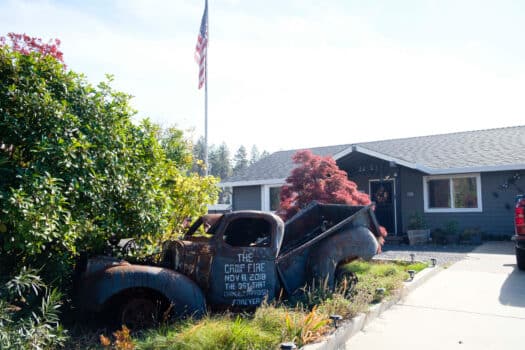
### Deadly Blast at Givaudan Food Ingredients Plant Results in Two Fatalities, 11 Injured
In a heartbreaking industrial disaster, a significant explosion at the Givaudan Sense Colour facility in Louisville, Kentucky, has resulted in the deaths of two employees and left 11 others injured. The occurrence took place on November 12 and has profoundly affected the local community while igniting broader discussions surrounding workplace safety in industrial settings. Managed by the Swiss multinational Givaudan, the Louisville plant focuses on producing natural food colorings and other food ingredients for the international market.
### Circumstances Surrounding the Blast
Initial investigations indicate that the explosion was triggered by a cooking vessel utilized in the manufacturing processes at the site. Review of surveillance recordings as part of the inquiry suggests the blast was forceful enough to propel debris—including large pieces of a metal pressure vessel—onto the road outside the facility, demonstrating the intensity of the explosion.
At first, Givaudan had disclosed that all employees were accounted for. However, in the hours subsequent to the explosion, it became clear that miscommunication during staff roster verification had caused confusion. This led to the recommencement of search and rescue efforts, after which the bodies of the two deceased workers were unfortunately retrieved from the debris.
The 11 injured employees experienced varying levels of injuries and were taken to local medical facilities for treatment. Some have since been discharged, while others continue to receive care. The identities of the deceased and injured individuals have not yet been publicly disclosed pending family notifications.
### Ongoing Investigations: Emphasis on Workplace Safety
Several federal entities, including the Bureau of Alcohol, Tobacco, Firearms and Explosives (ATF) and the US Chemical Safety and Hazard Investigation Board (CSB), have initiated investigations into the incident. The CSB is specifically assessing whether safety protocols—both in the manufacturing procedures and regarding the equipment involved—were followed. This organization is responsible for evaluating if any systemic failures or regulatory oversights contributed to the explosion.
Witnesses and survivors have shared distressing accounts from the explosion. Initial reports indicate that the plant was functioning normally at the time of the incident. However, the precise cause of the explosion has yet to be established. Given the involvement of a pressurized cooking vessel, some specialists speculate that thermal or mechanical stress may have influenced the occurrence, potentially in conjunction with a maintenance oversight.
Investigators are also expected to scrutinize the engineering designs of the vessel and whether regular inspections were conducted in accordance with safety regulations. If any negligence is uncovered, it could lead to legal consequences and regulatory penalties against Givaudan.
### Givaudan and Community Response
Givaudan has publicly conveyed its sympathy for the victims and their families, stating that the company is fully cooperating with authorities to ascertain the explosion’s underlying cause. The organization also announced a temporary halt to operations at the Louisville site to prioritize the safety of its workforce and conduct a comprehensive inspection of equipment and safety practices.
“We are heartbroken by this tragic occurrence and are dedicated to supporting the impacted employees, their families, and the larger Louisville community during this challenging period,” a company representative stated in a press release.
The local community has rallied in response to the tragedy, with vigils and fundraisers set up to assist the families of the victims. Louisville Mayor Craig Greenberg visited the site and stressed the urgent need to assess and enforce industrial safety regulations to avert future calamities.
### Regulatory and Industry Consequences
This devastating incident has yet again highlighted the necessity for strong safety protocols in industries handling pressurized equipment and hazardous substances. Manufacturing food ingredients often involves the use of specialized machinery subject to extreme temperatures and pressures. Without rigorous maintenance and frequent inspections, such equipment can pose serious risks to employees and nearby communities.
The incident at the Louisville plant may lead to increased focus on regulatory adherence not only in the food ingredients sector but also in other industries with comparable operational hazards. Advocates for worker safety, encompassing local unions and national organizations, have already called for enhanced workplace safety measures and increased scrutiny from agencies such as the Occupational Safety and Health Administration (OSHA).
The Givaudan explosion also serves as a poignant reminder that effective and dependable emergency response procedures—such as accurate accountability for employees—are vital during crises. Mistakes and delays in these processes can worsen the human toll of such events, as demonstrated in this case.
### Final Thoughts
The tragic explosion at the Givaudan Sense Colour facility has left an enduring impact on Louisville and raised serious questions regarding industrial safety standards. As the ATF, CSB, and additional investigators strive to uncover the cause of this calamity, attention is drawn to the importance of protecting the lives of workers nationwide.
Meanwhile, the families of the deceased and injured individuals are struggling with profound grief and uncertainty. This incident acts as a sobering reminder that workplace safety should never be jeopardized, and systemic efforts are essential to preventing similar tragedies in the future.